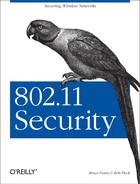Wireless networks are showing up everywhere. Corporations are deploying WLANs to allow employees to roam freely around corporate campuses without leaving the network. Some airports offer wireless access so business travelers can be continue to be productive while waiting for plane departures. Communities are banding together to provide wireless Internet access to homes that may not have direct access to wired broadband networks.
This rapid and widespread adoption would not be possible without a well-documented and structured set of protocols. The 802.11 family of protocols provides the basis for interoperability between equipment from different vendors. A PC card that utilizes the 802.11b specification from vendor A can communicate with an 802.11b-compliant access point from vendor B.
The IEEE is an internationally recognized standards setting body. The IEEE has a long history of approving and maintaining standards that set the stage for industry innovation.
The IEEE breaks their standards into various committees. The IEEE 802 Committee deals with Local and Metropolitan Area Networks. The 802 series of standards is broken into working groups that focus on specific issues within the overall discipline of LANs and MANs.
The following is a list of some of the working groups within the 802 series:
- 802.1
Bridging and Management
- 802.2
Logical Link Control
- 802.3
CSMA/CD Access Method
- 802.4
Token-Passing Bus Access Method
- 802.7
Broadband LAN
- 802.11
Wireless
The 802.11 Working Group was formed in September of 1990. Their goal was to create a wireless LAN specification that will operate in one of the Industrial, Scientific, and Medical (ISM) frequency ranges. The first 802.11 standard was released in 1997.
Tip
The ISM bands are ranges of radio frequency transmission that are set aside by the FCC for low-power unlicensed operation. Cordless phones, for example, commonly use the 900 MHz and 2.4 GHz bands. Various 802.11 protocols use either the 2.4 GHz band or the 5 GHz ISM bands.
The 802 standards address the lower levels of the OSI model. However, for those familiar with the OSI layered model, the 802 series splits the data link layer into two parts: Logical Link Control (LLC) and Media Access (MAC). The 802.2 standard defines a common LLC layer that can be used by other 802 MAC and Physical Layer (PHY) standards. The most common 802-based MAC and PHY standard is 802.3 CSMA/CD Access Method, otherwise known as Ethernet.
The 802.11 protocols address the MAC and PHY layers independently. The MAC layer handles moving data between the link layer and the physical medium. It is agnostic to the currently existing PHY standards that are in deployment today. Figure 1-4 shows how the lower layers of the OSI model match up to the concepts outlined in the 802 series of protocols.
There are many different PHY standards in use today. The original 802.11 specification documented three different mechanisms: Infrared, 2.4 GHz Frequency Hopping Spread Spectrum (FHSS), and 2.4 GHz Direct Sequence Spread Spectrum (DSSS). All these mechanisms provided a 1 or 2 Mb/s data rate depending on the signal quality. The original 802.11 specification had low throughput and interoperability problems. A card that implemented 802.11 with DSSS could not communicate with a device that used FHSS 802.11.
802.11b, released in 1999, specified a new PHY that provided a higher bit rate using DSSS in the 2.4 GHz range. 802.11b can transmit data up to 11 Mb/s but will scale down to 1 Mb/s based on conditions. Due to the higher bit rate and increased interoperability, 802.11b has gained rapid deployment.
After the interoperability problems of the first 802.11 specification, companies in the WLAN industry banded together and created Wireless Ethernet Compatibility Alliance (WECA). WECA certifies products that use the 802.11b protocol. Their certification mark is Wi-Fi, which stands for Wireless Fidelity. A product that has been stamped with the Wi-Fi logo is certified to interoperate with other Wi-Fi devices.
802.11a, a PHY released in 2001, operates in the 5 GHz range. It provides for a bit rate of up to 54 Mb/s and uses a new modulation method called Orthogonal Frequency Division Multiplexing (OFDM). Some vendors have proprietary implementations that double the bit rate of 802.11a to 102 Mb/s.
802.11g is the fourth PHY specification from the IEEE. It operates in the same 2.4 GHz range as 802.11b but uses OFDM like 802.11a. Operating at up to 22 Mb/s, it is seen as the middleman between the 802.11b and the 802.11a standards. Table 1-1 shows the 802.11 PHY specifications.
Table 1-1. PHY specifications
|
802.11 PHY |
Max Data Rate |
Frequency |
Modulation |
|---|---|---|---|
|
802.11 |
2Mb/s |
2.4GHz and IR |
FHSS and DSSS |
|
802.11b |
11Mb/s |
2.4GHz |
DSSS |
|
802.11g |
22Mb/s |
2.4GHz |
OFDM |
|
802.11a |
54Mb/s |
5GHz |
OFDM |
802.11b is currently the most deployed type of wireless LAN. Eleven separate channels can be selected for use in the 2.4GHz range. These channels actually have overlapping bands of frequencies, as illustrated in Figure 1-5. Using overlapping channels in nearby networks can cause bad interference. Most deployments have settled on using the three channels 1, 6, and 11, as this maximizes the number of non-overlapping channels available for use. Be especially aware of overlapping channels when deploying a network near the wireless LANs of other organizations; be a good neighbor, and don’t interfere with the frequencies already in use around you.


